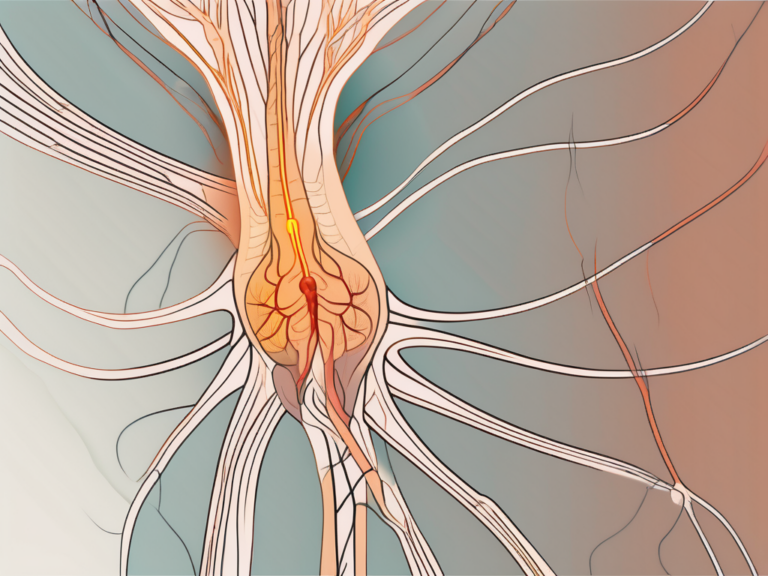What Is the Procedure Called for Injections to the Sacral Nerve?
Injections to the sacral nerve are a procedure commonly used to alleviate chronic pain and improve quality of life for individuals experiencing certain conditions. To truly understand the procedure, it is essential to grasp the significance of the sacral nerve and its role in the body. Furthermore, it is important to be aware of the conditions that may necessitate sacral nerve injections, the steps involved in the procedure, the potential risks and complications, as well as the alternatives available.
Understanding the Sacral Nerve
The sacral nerve is a crucial component of the nervous system, originating in the lower back and extending down the leg. It is responsible for controlling various functions in the lower body, including bowel and bladder control, as well as sexual function. Understanding the anatomy and functions of the sacral nerve is fundamental in appreciating the need for sacral nerve injections.
Anatomy of the Sacral Nerve
The sacral nerve consists of a network of nerves that emerge from the lower part of the spinal cord. These nerves branch out and provide vital connections to the pelvic organs, muscles, and sensory fibers in the lower extremities. Their intricate arrangement enables them to regulate specific bodily functions and transmit sensory information to the brain.
The sacral nerve is composed of five pairs of spinal nerves, known as S1 to S5. These nerves emerge from the sacral region of the spinal cord and extend downwards, forming a complex network. Each pair of nerves innervates different areas of the lower body, ensuring the proper functioning of various organs and muscles.
Within the sacral nerve, there are two main divisions: the anterior and posterior divisions. The anterior division carries motor fibers, responsible for controlling muscle movements, while the posterior division carries sensory fibers, transmitting information from the lower body to the brain.
As the sacral nerve extends down the leg, it gives rise to several branches that provide innervation to specific regions. These branches include the pudendal nerve, which controls the muscles of the perineum and external genitalia, and the sciatic nerve, which is the largest nerve in the body and provides sensory and motor innervation to the lower limb.
Functions of the Sacral Nerve
The sacral nerve plays a crucial role in the proper functioning of the bowels, bladder, and sexual organs. It facilitates the contraction of muscles involved in these bodily functions, allowing for control over urinary and fecal excretion, as well as sexual arousal and climax.
Specifically, the sacral nerve controls the contraction of the detrusor muscle in the bladder, which helps in the expulsion of urine. It also regulates the external urethral sphincter, allowing for voluntary control over urination. In terms of bowel control, the sacral nerve coordinates the contraction and relaxation of the muscles in the rectum and anus, facilitating proper defecation.
In addition to its role in urinary and bowel control, the sacral nerve is essential for sexual function. It controls the muscles involved in sexual arousal, such as the bulbospongiosus and ischiocavernosus muscles in males, and the clitoral and vaginal muscles in females. These muscles contribute to the pleasurable sensations experienced during sexual activity.
Furthermore, the sacral nerve transmits sensory information, enabling the brain to perceive sensations in the lower body. It relays signals related to touch, temperature, and pain from the pelvic region and lower extremities to the brain, allowing for the perception and interpretation of sensory stimuli.
In summary, the sacral nerve is a complex network of nerves that plays a vital role in the proper functioning of the lower body. Its intricate anatomy and functions contribute to essential bodily processes, including bowel and bladder control, as well as sexual function. Understanding the intricacies of the sacral nerve is crucial in recognizing the importance of sacral nerve injections and their potential therapeutic benefits.
The Need for Sacral Nerve Injections
There are certain conditions in which sacral nerve injections can provide relief and improve the quality of life for individuals experiencing chronic pain or dysfunction. These injections are often considered when other treatment options have been unsuccessful or are not suitable for a particular patient.
Sacral nerve injections involve the administration of medication directly into the sacral nerves, which are located in the lower back. The medication used in these injections can vary, but it is typically a combination of a local anesthetic and a corticosteroid. The local anesthetic provides immediate pain relief, while the corticosteroid helps reduce inflammation and provide longer-term relief.
Conditions Treated by Sacral Nerve Injections
Sacral nerve injections are commonly used to address conditions such as chronic pelvic pain, overactive bladder, interstitial cystitis, and fecal incontinence. Chronic pelvic pain refers to persistent pain in the lower abdomen and pelvic region, which can be caused by a variety of factors such as endometriosis, pelvic inflammatory disease, or irritable bowel syndrome. Overactive bladder is characterized by a sudden and frequent urge to urinate, often leading to urinary incontinence. Interstitial cystitis is a chronic condition that causes bladder pain and urinary urgency. Fecal incontinence refers to the inability to control bowel movements, leading to involuntary leakage of stool.
These conditions can significantly impact an individual’s daily life, causing discomfort, embarrassment, and limitations in their activities. Chronic pelvic pain can make it difficult to engage in physical activities or enjoy sexual intercourse. Overactive bladder and interstitial cystitis can disrupt sleep and affect social interactions due to the constant need to urinate. Fecal incontinence can lead to feelings of shame and isolation.
Sacral nerve injections offer a potential solution to alleviate these symptoms and restore normalcy. By targeting the sacral nerves, these injections can help block pain signals and reduce inflammation in the affected area. This can lead to a significant reduction in pain and discomfort, allowing individuals to regain control over their daily activities and improve their overall quality of life.
Symptoms Indicating the Need for Sacral Nerve Injections
Indicators that may suggest the need for sacral nerve injections include persistent pain in the pelvic region, frequent urination or urinary urgency, difficulty controlling bowel movements, and sexual dysfunction. Persistent pain in the pelvic region can be a sign of underlying conditions such as endometriosis, pelvic inflammatory disease, or nerve damage. Frequent urination or urinary urgency may indicate an overactive bladder or interstitial cystitis. Difficulty controlling bowel movements can be a symptom of fecal incontinence or nerve damage in the lower back. Sexual dysfunction can be caused by pelvic pain or nerve damage.
However, it is crucial to consult with a healthcare professional to properly diagnose these symptoms and determine whether sacral nerve injections are an appropriate course of action. A thorough evaluation, including a physical examination and possibly imaging tests, may be necessary to identify the underlying cause of the symptoms and determine the most effective treatment approach.
The Procedure for Sacral Nerve Injections
Understanding the steps involved in this procedure is essential for individuals considering sacral nerve injections as a potential treatment option. Familiarizing oneself with the necessary preparations, the injection process itself, and the subsequent care and recovery will help individuals make informed decisions regarding their healthcare.
Preparing for the Procedure
Prior to the sacral nerve injection, a thorough assessment of the patient’s medical history, physical examination, and possibly imaging studies will be conducted. This information will help the healthcare provider determine the precise location for the injection. It is important to inform the healthcare provider about any medications, allergies, or existing medical conditions to ensure a safe and effective procedure.
During the assessment, the healthcare provider will also discuss the potential risks and benefits of the procedure with the patient. This open and honest conversation allows the patient to ask any questions or express any concerns they may have. It is crucial for the patient to have a clear understanding of the procedure and its potential outcomes before giving their consent.
Once the patient is deemed suitable for the sacral nerve injection, they may be instructed to refrain from eating or drinking for a certain period of time before the procedure. This fasting period helps minimize the risk of complications during the injection.
Step-by-Step Process of the Injection
The injection is typically performed as an outpatient procedure, and local anesthesia may be used to minimize discomfort. The patient will be positioned in a way that allows the healthcare provider easy access to the sacral area. The skin over the injection site will be cleaned and sterilized to reduce the risk of infection.
Utilizing fluoroscopic imaging guidance, the healthcare provider will identify the precise location to introduce the medication. Fluoroscopy is a real-time X-ray imaging technique that provides continuous visualization of the needle’s position, ensuring accurate placement of the injection.
A thin needle is then carefully inserted into the sacral area, guided by the fluoroscopic images. The patient may feel a slight pinch or pressure as the needle is inserted, but the local anesthesia helps minimize any discomfort. Once the needle is in the correct position, a small amount of contrast dye may be injected to confirm the needle’s placement and ensure that the medication will reach the intended area.
Finally, a steroid medication is injected into the targeted nerve or nerve roots. The medication helps reduce inflammation and alleviate pain. The entire process is generally completed within a few minutes, and the needle is then removed.
Post-Procedure Care and Recovery
Following the sacral nerve injection, it is common to experience some soreness or increased pain at the injection site. This discomfort is usually temporary and can be managed with ice packs and over-the-counter pain relievers, as recommended by the healthcare provider.
It is important to note that the effects of sacral nerve injections vary from person to person. While some individuals may experience immediate pain relief, others may require multiple injections or a few days to weeks before experiencing the full benefits of the procedure.
During the recovery period, the healthcare provider may provide specific instructions regarding post-procedure care. This may include avoiding strenuous activities, taking prescribed medications, or attending follow-up appointments to monitor progress. It is crucial to follow these instructions diligently to ensure optimal recovery and maximize the potential benefits of the sacral nerve injection.
If the patient experiences any unexpected or concerning symptoms after the procedure, such as severe pain, fever, or signs of infection, it is important to contact the healthcare provider immediately. Prompt communication with the healthcare team can help address any complications or concerns in a timely manner.
In conclusion, sacral nerve injections are a valuable treatment option for individuals suffering from chronic pain. By understanding the procedure’s steps, preparing adequately, and following the healthcare provider’s instructions for post-procedure care and recovery, patients can make informed decisions and optimize their chances of achieving pain relief and improved quality of life.
Risks and Complications of Sacral Nerve Injections
As with any medical procedure, sacral nerve injections carry potential risks and complications. Understanding these possible outcomes is crucial for individuals considering this treatment option.
Sacral nerve injections are a commonly used treatment for various conditions, including chronic pain and bladder dysfunction. The procedure involves the injection of medication into the sacral nerves, which are located in the lower back region. While the injections can provide significant relief for many patients, it is important to be aware of the potential risks and complications that may arise.
Potential Side Effects
Common side effects of sacral nerve injections may include temporary discomfort at the injection site, bruising, or bleeding. These side effects are usually mild and resolve on their own within a few days. However, in some cases, the discomfort may persist or worsen, requiring further medical attention.
In addition to temporary discomfort, there is a small risk of infection or allergic reactions to the injected medication. Infections can occur if proper sterile techniques are not followed during the procedure. Allergic reactions, although rare, can manifest as skin rashes, itching, or difficulty breathing. It is important to discuss these potential side effects with the healthcare provider and seek immediate medical attention if any concerning symptoms arise.
Long-Term Risks
While sacral nerve injections are generally considered safe, there is a minimal risk of more severe complications, such as nerve injury, bleeding, or nerve damage. These risks, however, are rare when the procedure is performed by a skilled healthcare professional with expertise in the field.
Nerve injury can occur if the needle used during the injection damages the surrounding nerves. This can lead to persistent pain, numbness, or weakness in the lower back, buttocks, or legs. Bleeding is another potential complication, although it is uncommon. Excessive bleeding can cause hematoma formation, which may require further medical intervention.
Nerve damage is a rare but serious complication that can result from sacral nerve injections. This can lead to long-term or permanent changes in sensation, muscle function, or bladder control. However, it is important to note that the risk of nerve damage is extremely low when the procedure is performed by an experienced healthcare provider.
Consulting with a healthcare provider will help determine the individual risk associated with the procedure. They will evaluate the patient’s medical history, perform a thorough examination, and discuss the potential benefits and risks of sacral nerve injections. In some cases, alternative treatment options may be considered to minimize the risk of complications.
Effectiveness of Sacral Nerve Injections
Understanding the anticipated outcomes and factors influencing the success of sacral nerve injections is key to managing expectations and making informed decisions about treatment.
Expected Outcomes
The primary goal of sacral nerve injections is to relieve pain and improve various functions affected by the underlying condition. Results can vary from individual to individual, with some experiencing significant pain relief and restoration of normal bodily functions, while others may have more modest improvements. It is important to discuss realistic expectations with a healthcare provider to better understand the potential outcomes.
Factors Influencing the Success of the Procedure
Several factors may influence the effectiveness of sacral nerve injections, including the specific condition being treated, the severity and duration of symptoms, individual patient characteristics, and adherence to post-procedure care and rehabilitation. Collaborating closely with healthcare professionals and following their guidance will optimize the chances of achieving successful outcomes.
Alternatives to Sacral Nerve Injections
While sacral nerve injections can be an effective treatment option, it is essential to consider alternative approaches to address the underlying conditions in certain cases. These alternatives may involve non-surgical or surgical interventions.
Non-Surgical Alternatives
Non-surgical alternatives to sacral nerve injections may include physical therapy, medications, nerve stimulation techniques, or alternative therapies. These options offer individuals the opportunity to explore different approaches and find a solution that best suits their preferences and medical needs. Consulting with a healthcare provider will help determine the most appropriate alternatives.
Surgical Alternatives
In some instances, when conservative measures have been unsuccessful, surgical interventions may be considered. Surgical alternatives for conditions requiring sacral nerve injections depend on the specific diagnosis and individual circumstances. It is important to thoroughly discuss the potential risks, benefits, and long-term outcomes of surgical procedures with a knowledgeable healthcare provider.
In conclusion, sacral nerve injections are a procedure commonly used to address certain conditions causing chronic pain and dysfunction. By understanding the anatomy and functions of the sacral nerve, as well as the conditions that may indicate the need for these injections, individuals can make informed decisions about their healthcare. Familiarity with the procedure, potential risks, and alternative treatment options allows individuals to collaborate closely with healthcare professionals to determine the most appropriate course of action. It is crucial to consult with a healthcare provider specializing in this area to ensure the highest level of care and maximize the potential benefits of sacral nerve injections.




